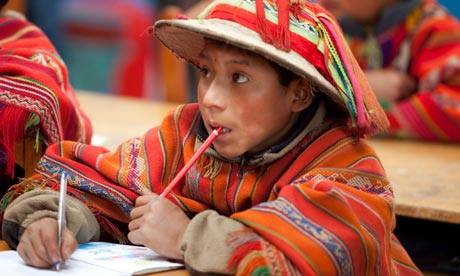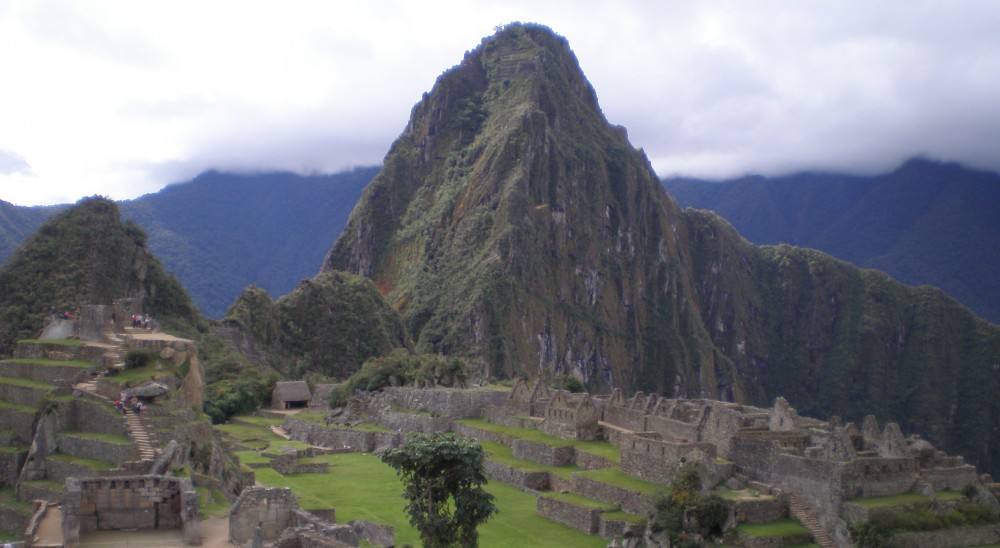
You Tube Video by UNICEF Peru-Bilingual Education:
https://www.youtube.com/watch?v=9yvRkcGxFV4
This video shows the need for bilingual education in Peru. It shows a classroom where the teacher speaks Spanish and the students don’t understand. It shows that indigenous people know their history and have knowledge from their communities. However, if the concepts are taught in a foreign language, then they won’t understand the concepts. It shows the history of colonialism and the assumed hierarchy of Spanish and colonialized modes of instruction.
The news reporter states” Intercultural and Bilingual Education is a right!”
Portion of dialog translated:
Teacher: Good day. We’re going to go over the last history class and the first question is…Vanessa, who discovered America?
Student: I don’t understand anything teacher.
Teacher: Well, you tell me, why is it a necessity to discover a new continent?
Student B: I don’t understand anything. You don’t know what I’m saying.
Later in the video: A student says, “ If you understood my language, I would learn.”
Indigenous Education: Bilingual and Bicultural Rights
Background/History
Peru has a wealth of diversity within the country. Indigenous peoples alone make up 45% of the population and include Quechua, Aymara, Shipibo, Achuar, Aguaruna, and Ashaninka. The largest group is the highland Quechua with about 4.5 million speakers. Aymara speakers also make up a large population of 500,000 people located in southern Peru near Puno. (UNHCR 2007, http://www.refworld.org/docid/4954ce0b2.html)
In reaction to the large amount of linguistic and cultural diversity, the Peruvian government has approached these varied populations with education policies since 1972. The main goal was to help indigenous speakers transition into Spanish and at the same time preserve indigenous languages and cultures (Cueto, Guerrero, León, Seguin & Muñoz, 2009). In 1989, a new department called the Directorate of Bilingual Education (DIGEBIL) was formed, which worked on formulating bilingual and bicultural education policy within the country. “The DIGEBIL policy for intercultural education recognized Peru as a multiethnic, pluricultural and plurilingual country, which should respond with education systems to promote a dialog between cultures” (Aikman, 1997). Since then, the Ministry of Education has printed over 3 and a half million textbooks in math and language arts in Quechua, Aymara, and 9 Amazon Languages (Cueto, Guerrero, León, Seguin & Muñoz, 2009).
Challenges
Despite some of these sweeping changes in policy, the education system in Peru has experienced various challenges to bilingual and bicultural education. One challenge was in 1994, when the great strides of five years of DIGEBIL planning were dissolved by Fujimori as a “threat to national unity”(Aikman, 1997). In his lead, regional power was dissolved and centralization was key. Spanish was seen as a way to unite a “national culture” (Aikman, 1997).
The history of colonialism in Peru also has to be taken into account. How can intercultural and bilingual education be seen as equal to Spanish, when historically Spanish has been the dominant group? The idea that each language and culture should have equal respect is written into policy, but the reality is that Spanish is still seen as the dominant language. Further, some problems in implementing these programs come from the value system indigenous groups themselves have invested in Spanish. Some see assimilation as the only way to succeed and have economic opportunities. Therefore, to this day, indigenous languages and Spanish are not on equal levels in respect to usefulness (Cueto, Guerrero, León, Seguin & Muñoz, 2009).
To further the challenge of true bilingual and bicultural education is the lack of implementation in schools. Bilingual programs now exist for primary education, but are only available to half the students in need of those programs. Additionally, many policies have been put into place, but there are few qualified teachers that can teach bilingual education.
“For instance Cueto and Secada (2003) in a study for 4th and 5th graders found that in many EIB schools (Bilingual schools) in Puno, south of Peru, less than half of the teachers at EIB schools could not read or write in the indigenous languages (in fact some teachers assigned to EBI schools declared that they did not even speak the local language), language of instruction in the classroom was almost exclusively Spanish and bilingual materials and texts from the Ministry of Education were not used and piled up in a corner of many classrooms (only materials in Spanish were used).” (Cueto, Guerrero, León, Seguin & Muñoz, 2009)
An additional challenge is an economic one. In Sara Snyder’s article, The roots and repercussions of educational inequality on the indigenous populations of Peru, she argues, “the marginalization of the indigenous in Peru is correlated with low allocation of educational resources to the indigenous population”. Often the poorest areas of Peru are rural and indigenous. The lack of educational funding to these areas could be a result of economic racism against indigenous groups. Snyder uses the example that Lima and Moquequa have the same percentage of poverty level, yet Lima receives more government funding for education. Additionally, children in rural indigenous-speaking schools tend to have greater grade-repetition rates, dropout rates, and lower test scores in math and reading than children in Spanish-speaking urban schools. Moreover, the schools they attend are more likely to have poorer infrastructure than their peers in urban schools.
Successes
Despite various roadblocks in the implementation of bilingual programs, some programs have been successful. For example the PFMB program (Formación de Maestros Bilingües) is a teacher-training program in Iquitos that was formed by indigenous groups. It promotes participation of the community, collectivist viewpoints, and creates leadership positions for people working in education. The program takes into account indigenous philosophy and perspectives and creates a cross-cultural learning environment.
Additionally, the Harakmbut People, located in the Southern Amazon region have been fighting for their indigenous rights and education. They have been taught by outsiders and their land use has been dictated by outside oil interests. They are leaders of the inter-ethnic regional indigenous organization (FENAMAD), member of the national organization (AIDESEP-Association for the Development of the Peruvian Amazon), and part of an international organization (COICA- Coordinator Indigenous Organizations of the Amazon). They have participated in creating the Declaration of Rights of Indigenous Peoples through the UN working group in Geneva. They are actively working to provide education in their own language and from a culturally relevant perspective. Currently “indigenous groups are designing and implementing their own intercultural education programs with NGO funding, UN agencies such as UNICEF, and with bilateral aid channeled through governments” (Aikman, 1997).
Hopes for the Future
In response to the historical challenges, it seems clear that the best approach is to take education to a regional level and assess the need in that area. It shows that decentralization is the key to indigenous education and rights. Moreover, even if good policy is put into place, the implementation of that policy at a regional level needs to reflect the policy. It shows that the best practice is to recruit and train local teachers that speak the language and know the culture to teach in those local areas, rather than recruiting teachers from urban centers that are not familiar with the language or culture.
The example of the Harakmbut People indicates the need for similar opportunities for indigenous collaboration and leadership in the planning and execution of the education system. Only through bilingual and bicultural collaborations will the needs of these local and regional groups be met.

References
Cueto, S., Guerrero, G., León, J., Seguin, E., & Muñoz, I. “Paper commissioned for the EFA Global Monitoring Report 2010, Reaching the marginalized”, (2009). Explaining and overcoming marginalization in education: a focus on ethnic/language minorities in Peru.
Aikman, S. (1997). Interculturality and intercultural education: A challenge for democracy. International Review of Education, 43(5-6), 463-479.
Snyder, S. (n.d.). The roots and repercussions of educational inequality on the indigenous populations of Peru. Stanford Journal of International Relations, 10(1), 52-59.
Minority Rights Group International, World Directory of Minorities and Indigenous Peoples – Peru : Overview, 2007, available at: http://www.refworld.org/docid/4954ce0b2.html
Garcia, M. (2003). The politics of community education, indigenous rights, and ethnic mobilization in Peru. Latin American Perspectives, 30(128), 70-95. Retrieved from http://lap.sagepub.com/content/30/1/70
Piedra, M. (2009). Hybrid Literacies: The case of a Quechua community in the Andes. Anthropology & Education Quarterly, 40(2), 110-128.


